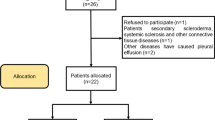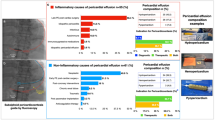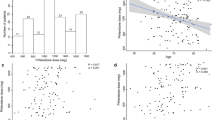Abstract
Study design: Single-subject case (a quadriplegic female, 56 years).
Objectives: To describe a new case of eosinophilic pleural effusion induced by dantrolene chronic administration.
Setting: Physical medicine and rehabilitation unit in a teaching hospital, France.
Methods: Diagnosis of an eosinophilic pleural effusion induced by dantrolene without any respiratory symptoms, except a decrease of breath sounds on the right lung base.
Results: Chest radiograph revealed a right-sided pleural effusion, and blood cell count a significant peripheral eosinophilia. Thoracenthesis contained 85% of eosinophils. The other explorations eliminated other causes of pleural effusion. The diagnosis of drug-induced effusion was almost sure and led us to discontinue the dantrolene. After 3 months, she had completely recovered. These characteristics, similar to the eight other cases described in the literature, are essential for the diagnosis of pleural effusion induced by dantrolene.
Conclusion: Dantrolene, a long-acting skeletal muscle relaxant, is well known to induce liver side effects but it can also induce pleural pericarditis. The pathogenesis is still not clearly identified, but similarities of chemical structures of dantrolene and nitrofurantoine make us think that it could be the same mechanism. The association between dantrolene and nitrofurantoine may have contributed to the expression of the pleural effusion.
Similar content being viewed by others
Case report
A 56-year-old woman was admitted to the physical medicine and rehabilitation unit (PM&R) from May to December 1998 with an incomplete traumatic quadriplegia (ASIA A: Motor level C4 on the right, C5 on the left, sensory level C5), which occurred on April 1998. At 4 months after the accident, she was treated with baclofen (60 mg daily) for spasticity and 2 months later dantrolene sodium was prescribed (225 mg daily). She went back home in December 1998.
Owing to a urinary tract infection in March 1999, nitrofurantoin (150 mg daily) was administered for 20 days. A few days later, she was admitted in the PM&R unit for a decreased functional performance and pain related to an increase in spasticity (FIMTM score=65).
On examination she was afebrile. She had no respiratory complaints, but breath sounds were decreased in the right lung base. Chest radiograph showed a right-sided pleural effusion. Arterial blood gas measurements revealed: oxygen saturation 95.9%, PaO2 73 mmHg and PaCO2 37 mmHg. The respiratory vital capacity was evaluated at 2 l. White blood cell count was normal (8.060/mm3), but there was significant eosinophilia (1.840/mm3) that did not exist before. There was no inflammatory syndrome (CRP was 10 mg/l and the erythrocyte sedimentation rate was 22 mm/h). On 21st April, a diagnostic and therapeutic thoracentesis yielded more than 1 l of serosanguinous fluid with 13 160/mm3 erythrocytes, 2140/mm3 leukocytes (85% of eosinophils). The pleural fluid protein concentration was 43 g/l. Aerobic, anaerobic, fungal and mycobacterial cultures of the fluid as well as the cytological evaluation for malignant cells were negative. Liver function tests were normal, serum rheumatoid factor and serum antinuclear antibody were negative. An isotope ventilation–perfusion lung scan ruled out pulmonary embolism. Electrocardiogram and echocardiogram did not show pericarditis.
This clinical and paraclinical presentation led us to suspect a drug-induced pleural effusion. Therefore, the primary drug responsible was dantrolene sodium, which was prescribed to the subject from 7 months. It was immediately discontinued. After 7 days the peripheral eosinophilia had resolved, and the respiratory vital capacity had increased to 2.7 l. Chest radiographs were normal in June 1999. Improvement of pulmonary function was associated with decreasing spasticity and pain. The dose of baclofen was decreased to 90 mg daily and pain medications were discontinued. The patient was able to walk again with an ankle foot orthosis and a rollator as far as 40 m. She went back home in June 1999 (FIMTM score=73). The patient is regularly examined by a PM&R doctor, has never had new respiratory dysfunction and dantrolene has not been reintroduced. For the spasticity, baclofene and botulinum toxin injection were prescribed.
Review of the literature
We searched the MEDLINE database with ‘dantrolene and pleural effusion’ as keywords and found eight cases reported from 1979 to 2002. The incidence is rare but probably underestimated. Mahoney and Bachtel1 mention 19 other cases of pleural effusion, without any clinical description, since dantrolene has been used (1967). Sahn2 also refers to five other cases mentioned by Light. Table 1 describes the characteristics of the eight cases from the literature and our patient. Some similarities can be noticed: onset after chronic administration of dantrolene (>60 days); association with peripheral and pleural fluid eosinophilia; disappearance of symptoms after discontinuation of the drug; absence of other causes to explain the effusion. All the patients had a disease of the central nervous system without any respiratory dysfunction (normal chest radiograph) before the initiation of the treatment with dantrolene. Respiratory or cardiovascular symptoms have always been reported, such as coughing, shortness of breath, chest pain, tachycardia or fainting. As for the patient described here, who presented none of these symptoms, systematic clinical examination only led us to diagnose the pleural effusion. A low-grade fever (temperature 38–38.5°C) is often noticed,3,4,5 except for one patient who had a temperature of 39°C.5 Liver function tests were always normal. An elevated immunoglobin E concentration (50.4 μg/l) is reported only by Mahoney and Bachtel.1 Three pleural tissue biopsies revealed nonspecific inflammation. The chest radiograph always showed a pleural effusion, sometimes bilateral, sometimes with associated pericarditis, but never with any other pleural or pulmonary disease. Lung scan, ventilation–perfusion lung scintiscan or other examinations ruled out other etiology. No infection, pulmonary thromboembolic disease, malignancy or connective tissue disease were discovered. In only two cases, antinuclear antibodies were weakly positive with a titer of 1:10, which is not significant for lupus.4,5 All rheumatoid factor tests as well as tuberculin skin tests were negative. As a result, for all the authors, the diagnosis that came to mind was dantrolene-induced pleural effusion. Each time, the treatment consisted in discontinuing dantrolene, and for one case, in adding orally steroid therapy for 2 weeks (prednisone 40 mg daily) because of an early recurrence.6 After several months of follow-up, no case of relapse was noted and none of the patients were rechallenged with dantrolene. Sometimes, residual costophrenic angle blunting persisted on the chest radiograph, without any clinical repercussions.3,5 For one of the patients, spasticity was treated with diazepam and baclofen6 as for the other patients, the treatment was not reported. Our patient's spasticity is adequately controlled with baclofen (90 mg daily) and botulinum toxin injections.
Discussion
Medications are a rare etiology of pleural effusions, even though 15 drugs at least can induce them. Pleurisies occur more often with methysergide or other antimigraine agents. Eosinophilic pleural effusion (EPE), defined as containing more than 10% eosinophils and frequently associated with peripheral eosinophilia, represent 1–9% of all pleural exudates.7 A cause is identified in only 25% of EPE cases.8 The precise mechanism of drug-induced pleural disease is not entirely elucidated.
Dantrolene sodium is the only drug against spasticity that acts directly on the long-acting skeletal muscles, without any modification of the nervous conduction or neuromuscular transmission. It inhibits the movements of intracellular calcium, preventing it from getting out of the sarcoplasmic reticulum and therefore inducing a dissociation of the excitation–contraction coupling. It is used to treat spastic neurological disorders and malignant hyperthermia during anesthesia. Severe liver insufficiency is a definite contraindication to dantrolene sodium. The risks of toxicity on the liver range from asymptomatic transaminase elevation to fatal hepatitis.9 and are dose-dependent. Several cases of dantrolene-induced diseases are reported, but with no certitude about their pathogenesis.
An immunologic mechanism such as immediate-type hypersensitivity is suggested by the clinical presentation and the pleural and peripheral eosinophilia, but antidantrolene IgE is never found because of the chemical structure of the drug. Moreover, performing a radioallergosorbent test (RAST) is technically impossible.3 An immune complex reaction can be considered, but immunofluorescent studies of pleural tissue disclose only nonspecific inflammation with deposition of IgG and IgA, and no evidence of granular immune complex deposition.5
In summary, an allergic mechanism is strongly suspected because of the peripheral eosinophilia, the onset after chronic administration of the drug, the recovery after treatment discontinuation and the lack of other explanations despite extensive clinical and paraclinical evaluation.1,6 Obviously, a recurrence of the effusion after a new administration of the drug would be a powerful argument for an allergic reaction, but no such cases are reported.
It is interesting to note some similarities in chemical structure between nitrofurantoin and dantrolene.10 Nitrofurantoin is a urinary antimicrobial agent commonly implicated in pulmonary or hepatic allergic reactions. Many cases of acute pleuropneumonitis with eosinophilia are reported with nitrofurantoin use, and have been identified as a drug-induced allergic reaction.11,12 More recently, hepatic injury from nitrofurantoin frequently associated with autoantibodies and hyperglobulinemia has been described, without any correlation between the dose and the severity of the disease, in contrast to hepatotoxicity from dantrolene.10 Different immunologic mechanisms are proposed. There was evidence of in vitro lymphocyte sensitivity to nitrofurantoin in a few cases of acute pneumonitis and systemic lupus erythematosus induced by this agent.12,13 It is assumed that the pulmonary reactions are mediated by antigen–antibody complexes and studies on IgG and IgM antibodies and lymphocyte transformation tests have produced conflicting results.11 Cell-mediated and cytotoxic immune mechanisms can also be implicated.14 Thus, chemical structural similarities reinforce the hypothesis for an allergic basis to dantrolene-induced pleurisy, even if efforts to detect in vitro lymphocyte sensitization to dantrolene were unsuccessful.5 Three reasons may explain this failure: the testing was performed in only two cases; there was an important delay between the discontinuation of the drug and the in vitro testing; or the reaction involves a toxic metabolite or a short-lived by-product of dantrolene. So, even though the most frequent side effects are different (dantrolene and hepatotoxicity; nitrofurantoin and pulmonary disease), the association of these two medications could have precipitated the apparition of EPE in our patient.
In conclusion, even if its pathogenesis is uncertain and its incidence rare, dantrolene sodium-induced pulmonary toxicity must be recognized and recalled when unexplained pleural effusion or pleuropericarditis occurs. In fact, recovery is linked to the discontinuation of treatment, which should be done as soon as possible. Dantrolene is commonly used, and frequently associated with nitrofurantoin, in neurological patients. Systematic, regular and careful clinical examination is therefore recommended, especially for those patients who can have an atypical clinical presentation. Monitoring of pulmonary auscultation must be systematic and frequent when dantrolene sodium is administrated for over 60 days, particularly when associated with nitrofurantoin.
References
Mahoney JM, Bachtel MD . Pleural effusion associated with chronic dantrolene administration. Ann Pharmacother 1994; 28: 587–589.
Sahn SA . Immunologic diseases of the pleura. Clin Chest Med 1985; 6: 83–102.
Dohen F, Montagne V, Lelieur E . Pleurésie médicamenteuse au dantrolène : á propos d’un cas. Rev Pneumol Clin 2000; 56: 261–263.
Miller DH, Haas LF . Pneumonitis, pleural effusion and pericarditis following treatment with dantrolene. J Neural Neurosurg Psychiatry 1984; 47: 553–554.
Petusevsky ML et al. Pleuropericardial reaction to treatment with dantrolene. JAMA 1979; 242: 2772–2774.
Felz MW, Haviland-Foley DJ . Eosinophilic pleural effusion due to dantrolene: resolution with steroid therapy. South Med J 200l; 94: 502–504.
Hirsch A et al. Pleural effusion: laboratory tests in 300 cases. Thorax 1979; 34: 106–112.
Adelman M, Albelda SM, Gottlieb J, Haponik EF . Diagnostic utility of pleural fluid eosinophilia. Am J Med 1984; 77: 915–920.
Chan CH . Dantrolene sodium and hepatic injury. Neurology 1990; 40: 1427–1432.
Faling LJ, Petusevsky ML, Snider GL . Nitrofurantoin and dantrolene; liver and lung. Ann Intern Med 1980; 93: 151 (letter).
Holmberg L, Boman G . Pulmonary reactions to nitrofurantoin: 447 cases reported to the Swedish Adverse Drug Reaction Comittee 1966–1976. Eur J Resp Dis 1981; 62: 180–189.
Israel HL, Diamond P . Recurent pulmonary infiltration and pleural effusion due to nitrofurantoin sensitivity. N Engl J Med 1962; 266: 1024–1026.
Rosenow EC, De Remee RA, Dines DE . Chronic nitrofurantoin pulmonary reaction. Report of five cases. N Engl J Med 1968; 279: 1258–1262.
Benard A, Guenanen H, Tillie-Leblond I, Wallaert B . Pleurésies médicamenteuses. Rev Mal Resp 1996; 13: 227–234.
Author information
Authors and Affiliations
Rights and permissions
About this article
Cite this article
Lê-Quang, B., Calmels, P., Valayer-Chaléat, E. et al. Dantrolene and pleural effusion: case report and review of literature. Spinal Cord 42, 317–320 (2004). https://doi.org/10.1038/sj.sc.3101553
Published:
Issue Date:
DOI: https://doi.org/10.1038/sj.sc.3101553
Keywords
This article is cited by
-
Pleurotoxic Drugs—an Update: Someone Else to Blame?
Current Pulmonology Reports (2019)



